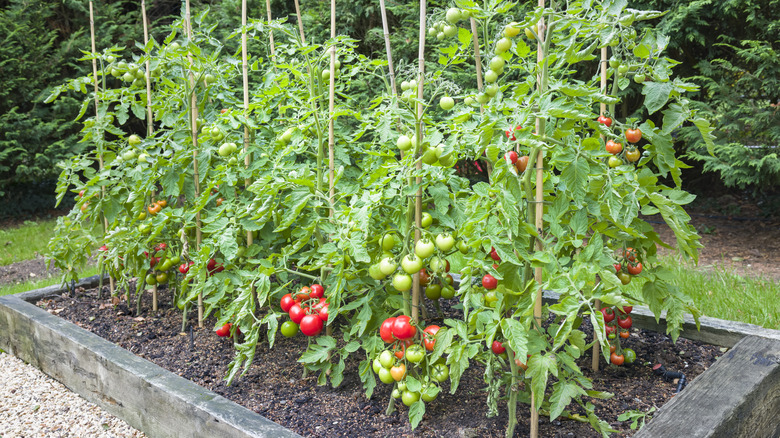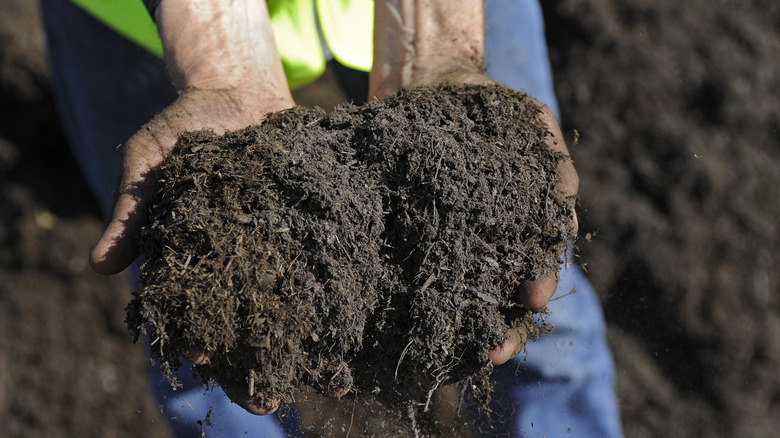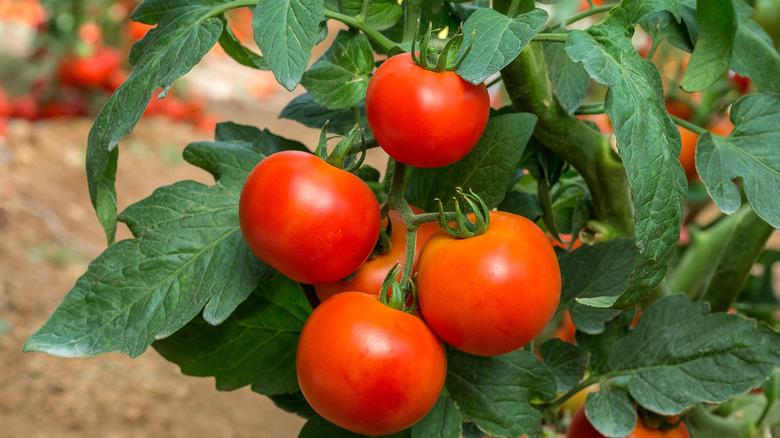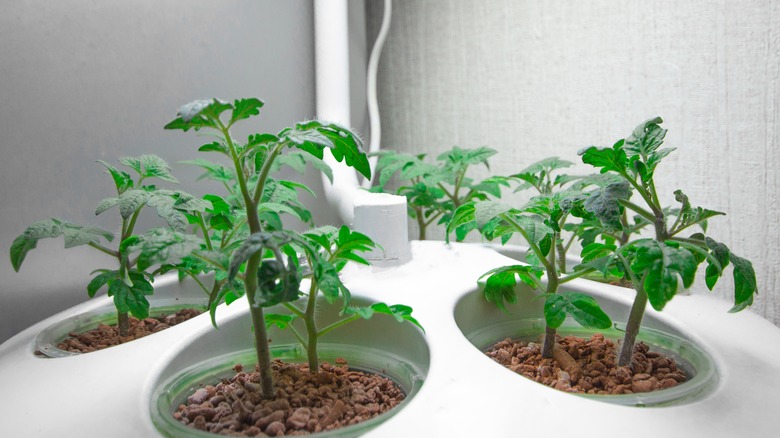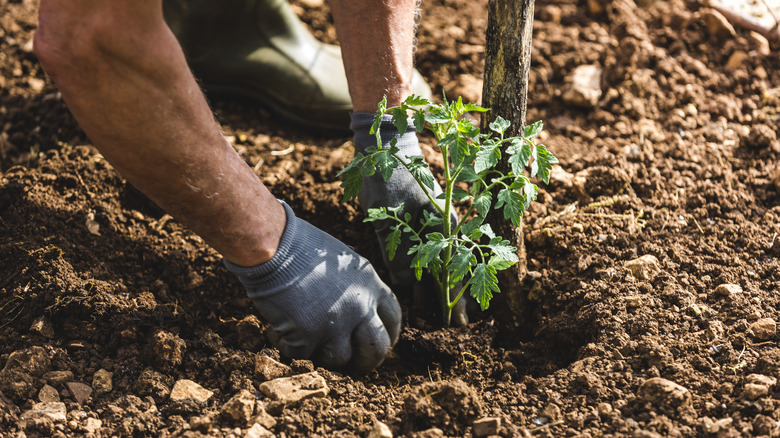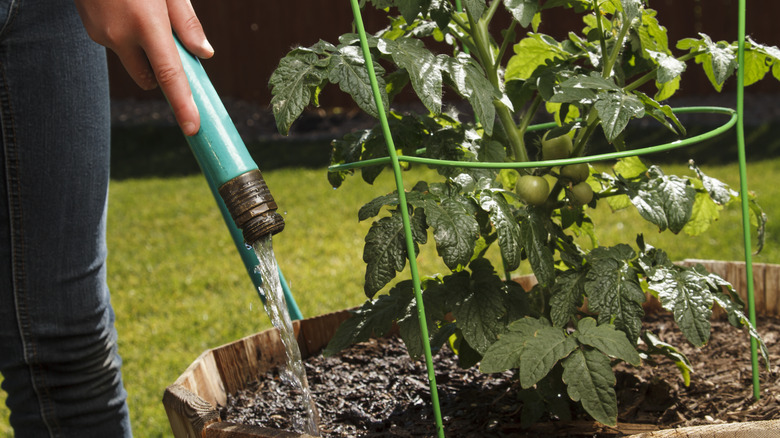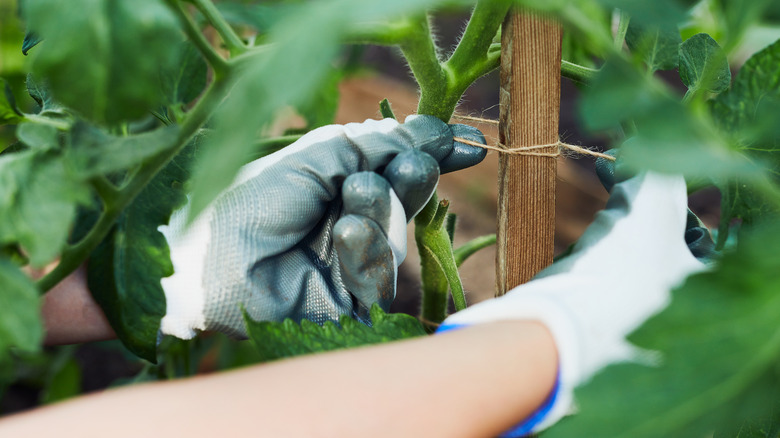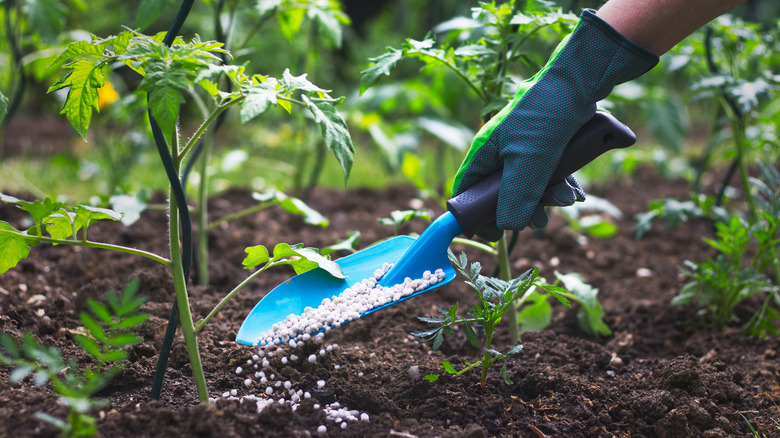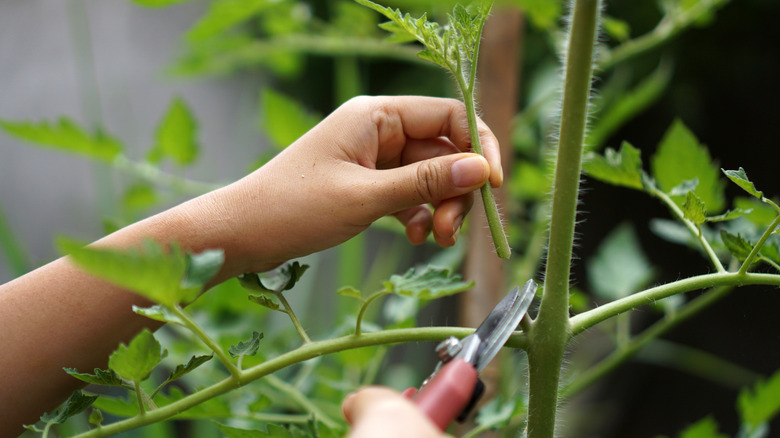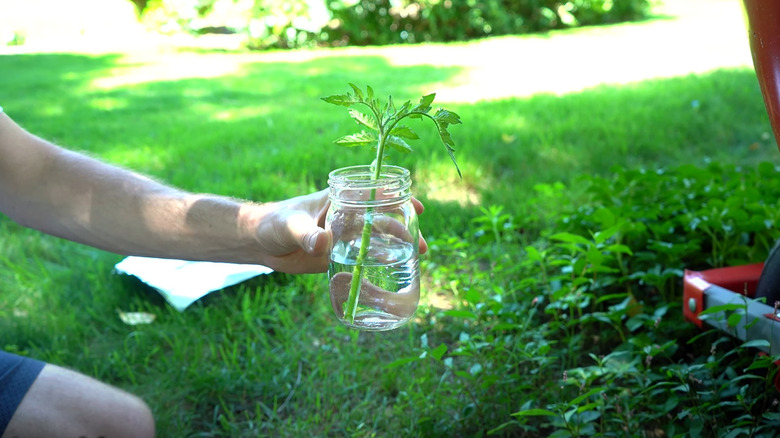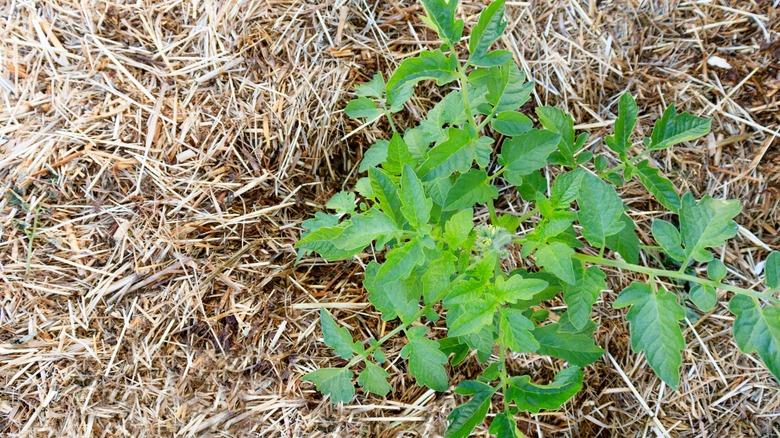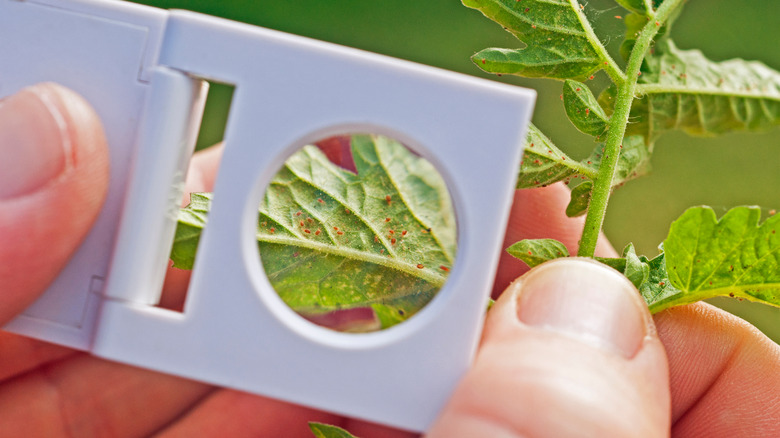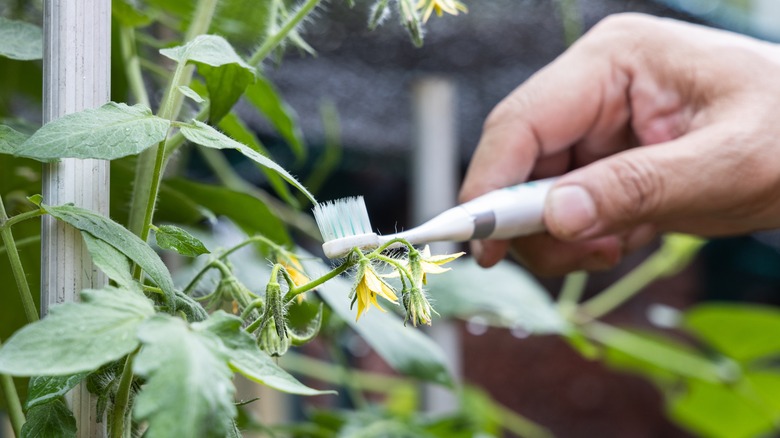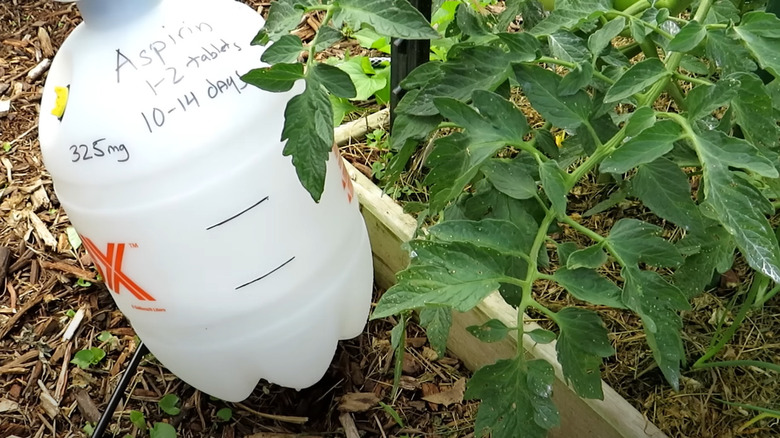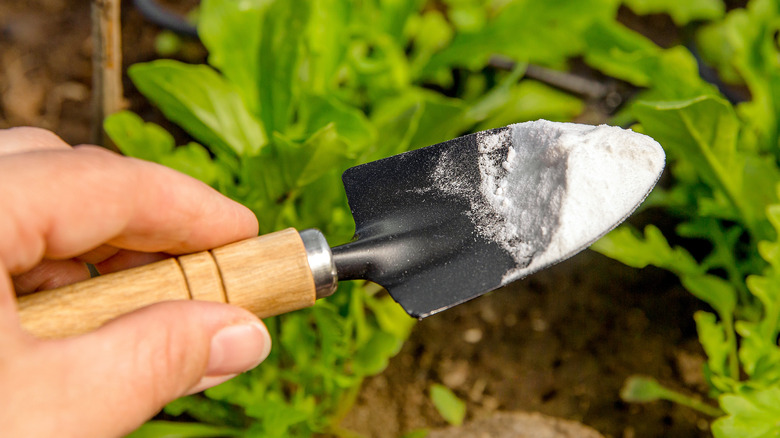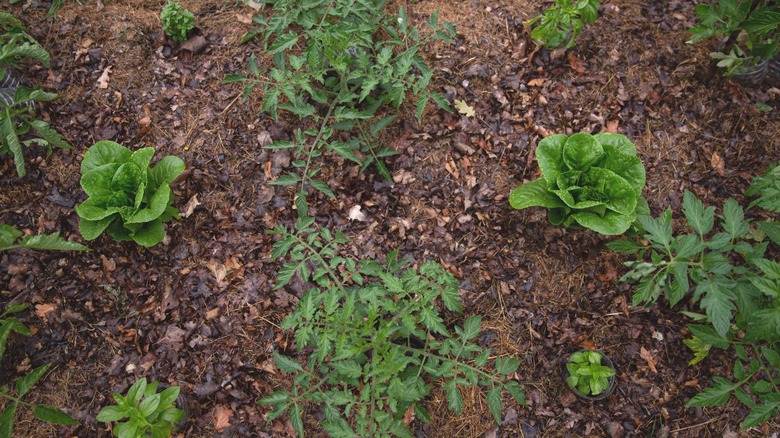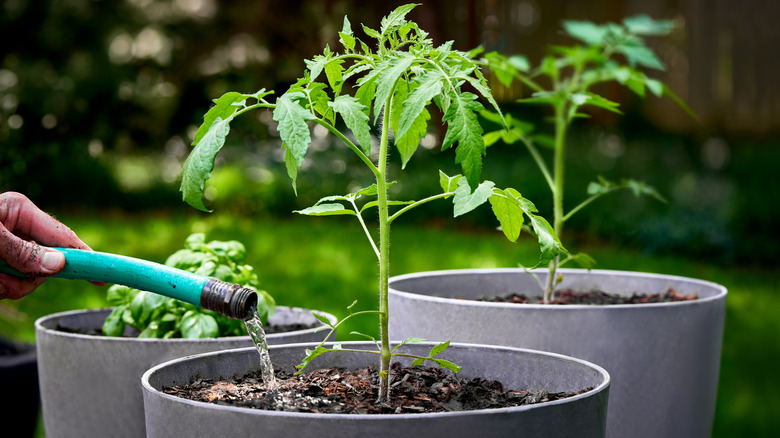The 18 Handiest Hacks To Remember When Growing Tomatoes
We may receive a commission on purchases made from links.
Wondering how to elevate your tomato-growing game to enviable heights? Picture yourself strolling through your garden, each step bringing you face-to-face with an army of juicy, crimson tomatoes awaiting their place in your harvest basket. Tomatoes are the superstars of the vegetable patch, yet many gardeners are all too familiar with the disappointment of a leaf-laden bush scantily dotted with fruit. "What's the secret to growing good tomatoes?" you muse. It's the gardener's riddle. Lucky for you, this article outlines 18 savvy hacks to follow when growing tomatoes in your garden — from turning your everyday discards into weapons against pests, diseases, and malnutrition to the subterranean secret of planting your seedlings deeper.
Growing tomatoes successfully isn't an elusive dream reserved only for seasoned gardeners. Bountiful harvests are surprisingly within the reach of an informed beginner. Plus, the immense pride of harvesting tomatoes in your backyard instead of grabbing them from the grocery store cannot be overlooked. For gardeners seeking to lean toward an eco-friendly approach, the news gets even better. The quest for vibrant tomato plants laden with juicy fruits need not hinge predominantly on synthetic compounds (think fertilizers, pesticides, and fungicides). Incorporated within these tomato growing hacks are various natural alternatives that ensure the health of your tomato plants while maintaining the vitality of your soil and safeguarding pollinators.
1. Pay attention to the soil
Envision a soil that's not just dirt but a living, breathing entity teeming with worms and microorganisms, all ready to champion your tomatoes' growth. Begin by enriching it with composted manure, the black gold for plants. You may also introduce fish leftovers — these slowly break down, releasing a banquet of nutrients that continuously feed your plants. Remember, tomatoes dance to the tune of slightly-acidic to neutral soil, with a pH that tiptoes around 5.5 to 7.0. Use a soil testing kit, and if the soil is too acidic, a sprinkle of lime does wonders, whereas sulfur swings the pH back if it's too alkaline.
2. Choose your varieties wisely
Embarking on a tomato-growing journey without selecting a variety suitable for your locality and needs is like setting sail without a compass. The bushy, determinate types like Roma and Florida 47 are your best mates for container gardening or canning. They wrap up their entire life story from seed to harvest in a short, predictable timeframe of four to six weeks. In contrast, if you're basking in endless summer vibes, indeterminate varieties (vining types) such as Black Krim, Big Beef, Sungold, or Cherokee Purple will suffice to offer a bounty that keeps on giving until frost plays its final card.
3. Give them enough sunlight
Tomato plants demand a generous stretch of six to eight hours of sunshine each day. Anything less, and you could end up nurturing leggy stems and lackluster fruits. Here's the catch: don't throw tomato seedlings into a full day of blazing sunbath right away. They need a gentle nudge to brace the outdoors several days before transplanting, much like dipping your toes first in a chilly pool. Begin with a couple of hours outside, and incrementally increase the sun exposure over the course of several days until transplanting time arrives. Post-transplanting, ensure no taller plants overshadow your tomatoes.
4. Plant tomato seedlings deep
Our next hack for getting the best tomatoes involves planting them deep into the ground. Instead of a light dusting of soil for your seedlings, take them on a deeper expedition, burying about ⅔ of the stem. Those small bumps on the stem are eager miniature explorers waiting to transform into an intricate network of roots that provide a sturdy base, amplify the nutrient and water uptake, and set the stage for a lusciously-loaded plant. Tomato roots also shiver at chilly temperatures. So, if you're in a colder climate, plunge a thermometer into your planting hole to ensure it's at least 65 degrees Fahrenheit.
5. Follow optimal watering techniques
Consistency is vital when watering your tomatoes — daily at first, then transition to that sweet spot of 1 to 1½ inches of water weekly after the first week of transplanting. But when the summer sun blazes down, the plants might need a bit more. However, channel the water directly to the plant's base. This technique is not just about watering efficiency, as it's also a shield against fungal diseases. In the age of convenience, a drip irrigation system can be your best ally. Imagine a network of petite hoses and drippers taking the guesswork and labor out of watering and delivering moisture right where it counts.
6. Support your tomato plants
The secret to having robust, disease-free tomatoes that reach for the skies isn't just in the nutrients or water. It's also about giving them a reliable support partner: staking. The easiest way is to secure the plant stem to a wooden stake at spaced intervals using a weatherproof string or plastic plant clips like the Dalzom Tomato Clips on Amazon. Staking tomato plants goes beyond garden aesthetics; it's a pragmatic way to dodge diseases and ground-roaming pests. Moreover, the elevation uplifts the leaves and fruits to bask in sunlight and breeze, putting them on a pedestal that maximizes photosynthesis, the linchpin of plant health.
7. Provide the right nutrients
Our next hack for successfully growing tomato plants is the art of feeding. Introducing a balanced NPK fertilizer lays down the red carpet, ensuring your seedlings can access all the essential nutrients from the get-go. But here's where the crescendo builds: later, shift the spotlight to a low-nitrogen, high-potassium formula. Think of nitrogen as the leaf maker and potassium as the matchmaker for fruits. Overzealous application of nitrogen can turn your tomato plant into a lush green with hardly any tomatoes. By boosting potassium, you invite your plants to focus their energy on producing those delicious fruits that are the whole point of this endeavor.
8. Prune for prosperity
The primary target of your tomato pruning endeavors is the suckers, those ambitious shoots that emerge in the crotch joint between the stem and a branch. By eliminating these, you channel the plant's resources into producing larger tomatoes. Don't leave out any diseased leaves or those sprawled over the soil. Late summer heralds the time to top off your indeterminate tomato plants — pruning off the top of the plant. While this may sound counterintuitive, it prevents the plant from expending energy on unfruitful vegetative growth. However, heed this warning: over-pruning or pruning the wrong parts of the tomato plant can lead to excessive stress.
9. Don't turn your back on those pruned suckers
Now, let's go over a gardening tactic that might seem counterintuitive at first but is a game-changer for a tomato love affair. Those healthy pruned suckers lying on the ground hold a secret: they're potential new tomato plants waiting to spring to life. By simply trimming the lower leaves from these suckers, rooting them in a jar of water, and transferring them into the soil or planting bag after a week, you harness what's essentially cloning technology right in your backyard. Standard tomato care and a bit of patience will reward you with new plants genetically identical to your best performers.
10. Mulching is a must
Mulching around your tomato plants doesn't just keep your soil moist; it also shields your plants from the scorching heat, keeping the soil cool and comfortable for your tomatoes. But that's not all. Mulch fights off the villain of our tale — the weeds, those insidious invaders that vie for nutrients. Further, by laying down a 2 to 3-inch protective layer of herbicide- and weed-free organic matter such as straw, grass clippings, or wood chips, you're not just mulching; you're creating a barrier that stops soil, a crafty carrier of diseases, from splashing onto your tomato plant's leaves during surprise showers.
11. Monitor and manage pests and diseases
Regular checks are your first line of defense against tomato pests and diseases, including cutworms, aphids, leaf spot, and blossom end rot. Think of it as your morning ritual, a quiet time with your plants to seek and identify the early signs of distress. Summoning predatory insects like ladybugs, wasps, and lacewings into your garden is like calling in the cavalry. These beneficial insects devour pests such as aphids and tomato hornworms, tipping the balance in your favor. Another strategic move in your arsenal is crop rotation. By shifting the location of your tomato plants annually, you're outmaneuvering soil-borne diseases, keeping your tomatoes thriving.
12. Optimize for pollination
Now, onto the world of pollination, where the flowers transform into luscious tomatoes. Even though tomato flowers are self-sufficient warriors with both male and female parts, sometimes (for example, when it's excessively humid or cold), they need a little nudge to prosper. Here's where you step in as the ultimate matchmaker. Creating a buzz (quite literally) by attracting pollinators with fragrant allies like chives and thyme ensures most flowers transform into juicy tomatoes. Furthermore, in greenhouses, indoors, or when the bees are busy elsewhere, becoming the pollinator yourself — gently vibrating the flowers with a finger, electric toothbrush, or pencil every three days— ensures no flower goes unnoticed.
13. Stagger your harvest windows
If you plant all your tomatoes simultaneously, you're setting the table for a feast that, frankly, is too much for one sitting. The fix is in the timing. Mix varieties with varying maturity periods — some, like the Sungolds, take a speedy two months, while others, like the Tasmanian Chocolate, prefer a leisurely 85-day stroll to maturity. That way, you spread your tomato bounty over several weeks. But suppose you've pledged your loyalty to just one variety. Staggered planting can be your game-changer — plant some seedlings now, save others for a couple of weeks later, and voilà, there won't be an unexpected tsunami of ripe tomatoes.
14. Try out the Aspirin foliar spray hack
One of the most surprising hacks for growing tomatoes involves something you likely have in your medicine cabinet — aspirin. The thread that links aspirin to healthier tomatoes is a fascinating bit of plant biochemistry. Tomato plants, it turns out, use salicylic acid (SA) to activate a defense mechanism known as Systemic Acquired Resistance (SAR), empowering the plants to fend off lots of pathogens, including bacteria and fungi. Enter aspirin, scientifically dubbed acetylsalicylic acid and quite the twin to SA. Simply dissolve a 325-milligram tablet of aspirin in a gallon of water and mist this blend onto your tomato plants every two weeks.
15. Use baking soda to help your plants
Our next trick involves a kitchen staple: baking soda. A mere quarter cup scattered around the base of your tomato plants packs a punch against pests, as it produces carbon dioxide when ingested. The sight and scent alone can steer rabbits away from your tomato plants, while snails meet their fate via dehydration. Meanwhile, it subtly nudges the soil's pH level upward, making it less acidic. Additionally, 1 tablespoon of baking soda, 1 teaspoon of vegetable oil, and some drops of dish soap in a gallon of water sprayed weekly on your tomato's foliage cloaks it with a protective barrier against fungal diseases.
16. Companion plant for strategic botanical friendship
How about pairing tomatoes with plants that offer benefits like deterring pests and improving soil health? For example, the fragrance of basil, parsley, cilantro, and garlic is an invisible cloak that deters pests like aphids, thrips, and spider mites. Within this selection of companion plants for tomatoes, some options like thyme, marigold, and chives go further to roll out the welcome mat for pollinators like the industrious bumblebees. Meanwhile, the humble nasturtiums unfold their leafy embrace upon the earth, unfurling a living mulch that preserves moisture, guards against erosion, and maintains a refreshing chill for tomato roots.
17. Utilize bone meal, Epsom salt, and egg shells
As heavy feeders, tomato plants demand more than what most soils can naturally supply. But amid your kitchen waste and household items, you have the ingredients for a homemade tomato feast. For example, ground egg shells pack a calcium-rich punch. Then, we move to bone meal, which brims with phosphorus and nitrogen, those all-important ingredients. Epsom salt, most beneficial when used at the beginning and middle of the growing season, shakes up a magnesium cocktail for your tomatoes, boosting the absorption of essential nutrients. When diluted in water, it can serve as a root drench or foliar spray.
18. Tips for growing tomatoes in pots
Not all tomatoes make the cut when it comes to container gardening. Compact varieties (like Tiny tim and Dwarf Eagle Smiley) are your best bet. Think big in terms of their homes — a pot at least 14 inches in diameter fits the bill. Now, set the stage with an artificial potting mix and carve out slits at the base for proper drainage. When the risk of frost is gone, plant your tomatoes deep, then water and fertilize accordingly. Should the weather throw a curveball with unexpected chilly nights, horticultural fleece will suffice to keep your green stars warm.

